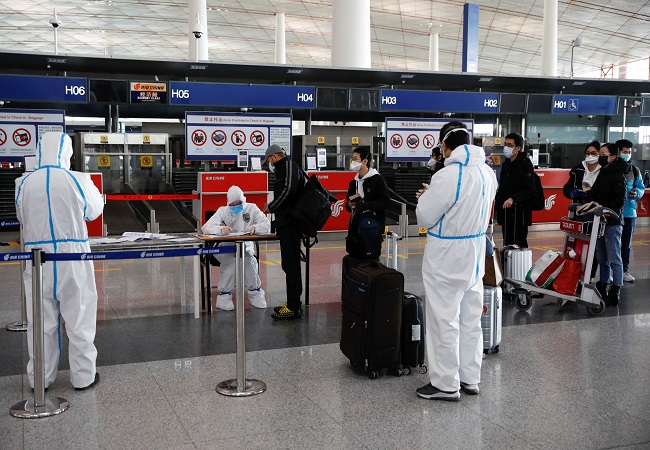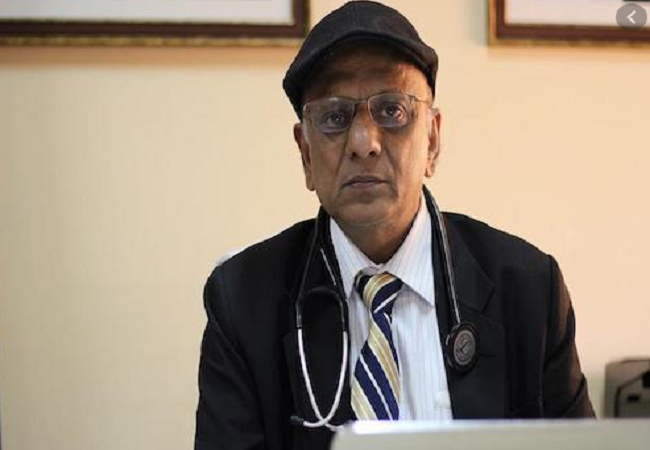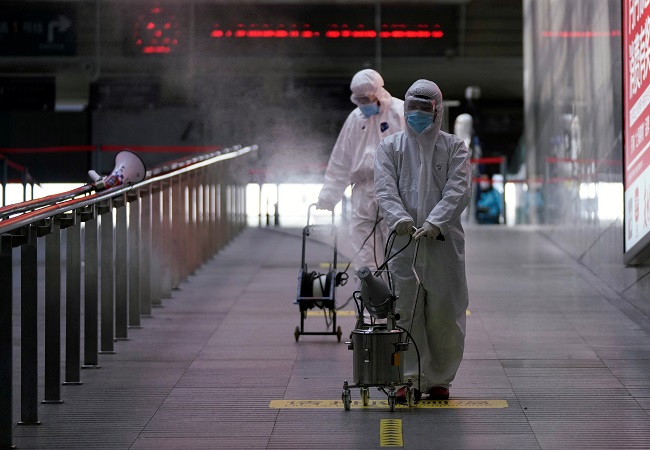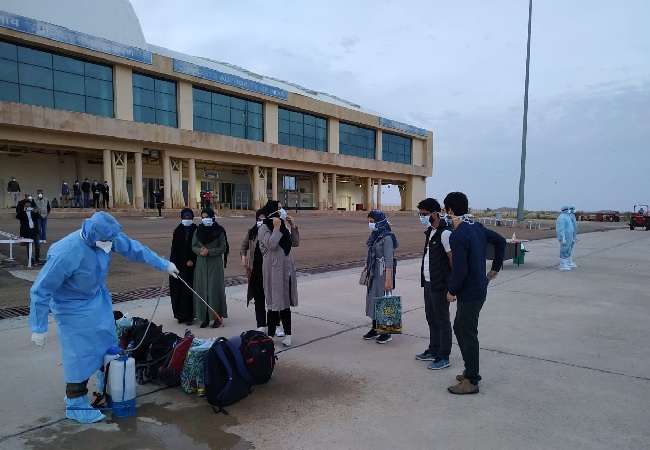
CHINA, Mar 16 (ANI): Staff members wearing protective suits register passengers in front of a check-in counter of Air China at Beijing Capital International Airport as the country is hit by an outbreak of the novel coronavirus, in Beijing on Monday. (Reuters Photo)

— By Dr KK Aggarwal
The Confederation of Medical Associations of Asia and Oceania (CMAAO) from different countries participated in a ‘virtual meeting’ on Saturday and discussed ways and means to tackle the Covid-19 pandemic. They also studied the ‘Corona containment model’ of various nations including India, Malaysia, Japan & others.
CMAAO represents 19 member National Medical Associations (NMAs).
Member NMAs
Dr KK Aggarwal, President CMAAO
Dr Yeh Woei Chong, Singapore, Chair CMAAO
Dr Rajan Sharma, National President IMA
Dr RV Asokan, Honorary Secretary General IMA
Dr Ravi Naidu, Past President CMAAO, Malaysia
Dr Alvin Yee-shing Chan, Hong Kong, Treasurer CMAAO
Dr Marie Uzawa Urabe, Japan JMA
Invitees
Dr Russell D’Souza, Unesco Chair in Bioethics Australia
Dr K K Kalra former CEO, NABH
Dr Sanchita Sharma Editor IJCP Group
Key points
There is a need to look after doctors and all health care professionals. Their safety cannot be compromised upon.
Every patient should be presumed to be COVID positive unless tested negative. Take universal precautions.
There is a shortage of PPE; PSUs, pharma or non-pharma industry, or anybody who wants to contribute should support the health care workers in this regard. These are extraordinary times. Hence, it would not be unethical to accept such help nor should there be any conflict of interest in this. These are lifesaving measures.

Announcing compensation for families of doctors, nurses and others in both public and private sectors who lose their lives in caring for Covid patients is not enough but instead resources must be brought to protect the frontline healthcare workers.
Reporting any death from SARI or unexplained death should be mandatory. Post mortem CT chest can be done for all patients brought in dead to find evidence of bilateral pneumonia.
Hospitals and clinics should remain open, instead of quarantining oe sealing them if a Covid +ve patient comes to the hospital. The concerned departments or premises should be closed down for one day for fumigation (if covid patient attends a non COVID designated clinic)
Singapore model
Singapore is facing a second wave of infection; 63000 citizens/permanent residents returned to Singapore (since Mid March , up to 1200 citizens come back daily from US and UK. Half of these patients coming back from London had Covid). Singapore also has outbreak of 511 cases in foreign worker dormitories, which house huge numbers of workers; one of the dorms has 20000 workers; 5 of these dorms are under lockdown.
There is new data coming out where the mean incubation period is 4 days and median serial interval is 4 days. Serial interval is the time interval between cases in a chain of transmission. This means there is pre-symptomatic transmission. The viral load is highest for the first 1 to 3 days of symptoms, starts decreasing till the 8th day and then peters out.

Hence, the need to wear masks, practice social distancing, hand hygiene and enforcing the one month-long lockdown period (all non-essential services and activities, including schools, closed since April 7). But, in Singapore, lockdown is called as “circuit breaker”. Since 25th March, all persons arriving in Singapore are not allowed to go home to their families, instead they are sent straight to a hotel for 14-day quarantine.
Cleaning and disinfection of contaminated surfaces is mandatory and clinic is closed for as long as necessary for this. The doctor is interviewed by the ministry. If wearing the right PPE, then he can carry on working. It also depends on how long the patient was in the clinic.
Malaysia model
• Malaysia has 4346 positive cases; there have been 70 deaths, 1830 have been discharged and 69 patients are receiving intensive care.
• Malaysia is in a state of lockdown “Movement Control Order (MCO)” since March 18. This period has been extended up to the end of April in view of the rising number of new coronavirus cases. Those found breaking the MCO are fined up to 1000 ringgit.
• There is a shortage of PPE for healthcare professionals.

• The pandemic has affected several businesses, including General Practitioners, especially those manned by doctors aged 60 or older.
• If a Covid patient has visited a clinic, the clinic including the doctor and staff is quarantined for 14 days and the clinic disinfected by MOH team.
Hong Kong model
• The pandemic seems to be easing. The latest total number of daily cases is ~1000. The number of new cases in a day has come down to 16 and we hope that this number comes down to 10.
• Stringent screening at airports and quarantine at home and at airports. There is a fine for breaking rules.
• One doctor has been found to be infected. But, the infection was not acquired in a hospital setting. There is zero mortality among doctors.
• The virus is silent in many “carriers”; relieving many cities from lockdown may be a big risk. But, there are financial implications to an extended lockdown.
India Model
• India is currently in lockdown till 14th April; the union government is meeting Chief Ministers of all states to decide whether to extend the lockdown.
• Containment zones and hotspots have been identified and sealed in an effort to contain clusters accompanied by strict monitoring.
• Three parameters: isolation/quarantine, respiratory etiquettes, personal hygiene; It is important to understand the seriousness of the situation.

• Testing has increased, so the number of cases has also increased.
• There is need for knowledge sharing and proactive working; adequate quality PPE.
• Quarantining a clinic or healthcare establishment gives it a stigma; hence, after appropriate cleaning process, the hospital should be ready to function again, instead of being quarantined for 14 days. The government of Gujarat has decided to close departments for 1-2 days, but not the entire hospitals in such an event.
Japan Model
• 153 health care workers have the infection (30 cases are not from hospitals)
• Infection is more common in age group 20-50 years
• Although there is “state of emergency”, but no hard lockdown; public has been asked to avoid the “3Cs”: Closed space, crowded places and close contacts to prevent the spread of infections
((The writer is President, CMAAO, HCFI and Past national President IMA))




